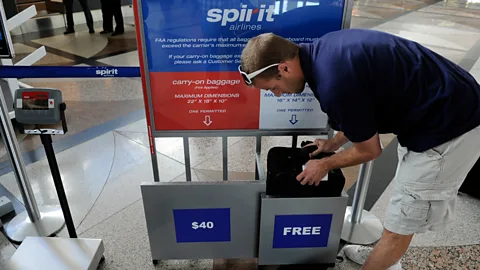The cost of flying on the cheap

Spirit Airlines, Ryan Air and Air Asia have made a business out of offering dirt-cheap airfares, but the experience of flying them may not be worth the price.
I have flown Spirit Airlines at least a dozen times, because it’s unquestionably the cheapest US airline if you manage to avoid its plethora of fees – but my experiences have ranged from generally unpleasant to downright infuriating.
The US’s only two-star airline in a five-star ranking system, according to airline ranking site Skytrax, Spirit is the exemplification of no-frills. There is no in-flight entertainment, even for a fee; seats on the new Airbus 320s don’t recline despite having a button for this purpose (a particularly irritating feature); and even a glass of water comes at a cost. With spring break quickly approaching in the US, plenty of university students will likely be attracted to the low initial price tag when booking their holiday – but the cost of flying cheap can be quantified in more than cash.
In number of flights and variety of destinations, Spirit dominates the US’ ultra low-cost market, a model that was pioneered by Ireland’s Ryanair and is now booming throughout Asia. These airlines rely largely on – and have been successful in – charging fees to turn a profit, something that can be extremely tricky in the airline industry. But while operators such as Air Asia have managed to strike a balance between extra fees and reasonable prices, Spirit has followed Ryanair’s business model of charging ludicrous fees for just about everything but the use of the bathroom (something Ryanair actually considered). While Spirit has yet to follow its Irish counterpart by charging ₤60 fees for printing boarding passes, they have a price for pretty much everything else, including storing bags overhead – something even Ryanair has yet to do.
On a recent trip, I checked prices for nine of the 10 Latin American cities that Spirit services (I did not consider going to Lima), and in seven of the nine cases, Spirit offered the cheapest flight, with savings ranging from $49 to $289 round trip. I ended up selecting Cartagena, the cheapest destination apart from San Salvador, and booked the flight exactly one month in advance for $375. The second cheapest flight to Cartagena was $489 on the Colombian-airline Avianca.
The $114 savings was worth it, but only because I’m a frugal, stubborn traveller. But many passengers don’t realise that if you can’t avoid the fees, flying Spirit makes about as much sense as paying somebody to punch you in the face.
Let’s say I wanted to put a bag overhead, which is not unheard of for an average passenger going abroad for eight days. That would cost an additional $70 round trip (more than the $60 it would cost to check it), bringing my ticket total to $445, saving only $44 from the Avianca flight. Virtually every other airline worldwide offers free checked bags on international flights and none charge to use the overheard bin.
And if I wanted to choose my seats instead of having Spirit select them at random, I’d have to pay anywhere from $10 to $25 – per segment. Middle seats cost more than window seats, by the way, because Spirit knows that passengers flying together will want to book seats next to each other.
The cheapest window seat for all four segments, including a layover in Fort Lauderdale, would have cost another $60, putting my total up to $505, $16 more than the Avianca flight (which also would have included movies, free checked bags, a free selection of seats that actually recline, a splash of water (or even beer) and, perhaps, even a smile).
Like Ryanair, Spirit often only makes sense if you are a light packer. In a recent Ryanair search, a ₤40 return ticket from Liverpool to Dublin turned into ₤102 after checking a bag (₤15 for 15kg), selecting seats (₤10 each segment) and checking in online (₤6 each way). On a sample Air Asia fare from Kuala Lumpur to Bangkok a 331 Malaysian ringgit flight went up to only 417 Malaysian ringgit after checking in a bag (36 Malaysian ringgit) and selecting a window seat (6 Malaysian ringgit) each way.
With all three airlines, though, it’s best to pay for your bag in advance. Spirit, for example, charges $50 for an overhead bag at the check-in counter and $100 if you wait until the gate.
Flying Spirit does have a few upsides. Being friendly at the check-in counter can get you a free window seat (as opposed to Ryanair which charges you more for waiting to book a seat), and the website has an incredibly user-friendly flight search. But my favourite thing about Spirit is that virtually every time I fly with the airline, I end up making friends. There often seems to be a sense of camaraderie among the passengers, a bonding over a common enemy.
I was once on a flight where the better part of the check-in line vocally rooted for a man as he tried to stuff his bag into the carry-on measuring box. When he succeeded in avoiding the fee, people cheered.
Yet, despite people’s distaste for Spirit, they – we – keep flying it, either because it’s worth the cost of flying cheap or because people just haven’t done the maths to realise how little money they are actually saving.
